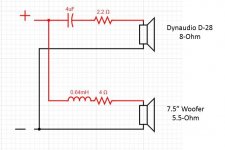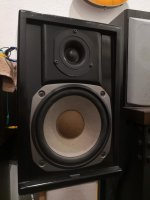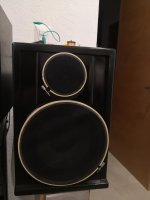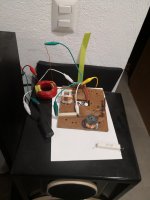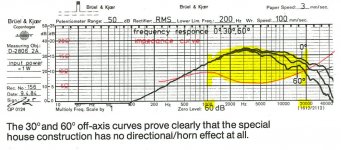Anyone bored enough to help me redo my lame attempt of an Xover?
Concept:
Combine a pair of eight(ish) woofers (7.5 inches actually) from some old Fisher 2-Ways and some Dynaudios D-28 tweeters into a decent two-way project. I decided to save and use the Fisher woofers since the cones are made of a "foamed" metal of some sort and could yield interesting results. As for the tweeters I had a good old pair of Dynaudio D-28 available so...
why not.
Restraints:
- KISS keep It Simple
- First Order / SECOND ORDER might be better¿?
-Use what is already available. Compromise.
To make the story short, I have no experience and I must learn from the process. I replicated the original dimensions of the Fisher boxes to have some reference as for the original engineering (if any) since I don´t have spec sheets for the Fisher´s drivers or way to measure them and thus the project became so far a trial and error kind of thing.
I´m happy(ish) with the sound (being listening to them for some months now) but I know my progress with the xovers is a sum of uneducated guesses and lots of listening. Will be fun to see what improvements we get with a more formal approach.😀
The xover started with an online calculator selecting 1900Hz as start point using 1st order Solen Split that yielded a 7.4uF cap for tweeter and 0.65 mH inductor for the woofer. From that point on trial and error evolved to the attached imaged where I added a resistor in series to the original components. 😱
TBH it sounds good but I´m sure you guys can help me take this ship to a better place.
Please don´t toss me into the flames this is my first time with speaker guts really. I´m reading some stickys related and I´m learning as I type LOL.
Cheers from Mexico.
Rob.
Concept:
Combine a pair of eight(ish) woofers (7.5 inches actually) from some old Fisher 2-Ways and some Dynaudios D-28 tweeters into a decent two-way project. I decided to save and use the Fisher woofers since the cones are made of a "foamed" metal of some sort and could yield interesting results. As for the tweeters I had a good old pair of Dynaudio D-28 available so...
why not.
Restraints:
- KISS keep It Simple
- First Order / SECOND ORDER might be better¿?
-Use what is already available. Compromise.
To make the story short, I have no experience and I must learn from the process. I replicated the original dimensions of the Fisher boxes to have some reference as for the original engineering (if any) since I don´t have spec sheets for the Fisher´s drivers or way to measure them and thus the project became so far a trial and error kind of thing.
I´m happy(ish) with the sound (being listening to them for some months now) but I know my progress with the xovers is a sum of uneducated guesses and lots of listening. Will be fun to see what improvements we get with a more formal approach.😀
The xover started with an online calculator selecting 1900Hz as start point using 1st order Solen Split that yielded a 7.4uF cap for tweeter and 0.65 mH inductor for the woofer. From that point on trial and error evolved to the attached imaged where I added a resistor in series to the original components. 😱
TBH it sounds good but I´m sure you guys can help me take this ship to a better place.
Please don´t toss me into the flames this is my first time with speaker guts really. I´m reading some stickys related and I´m learning as I type LOL.
Cheers from Mexico.
Rob.
Attachments
Last edited:
That 4R resistor will have to go (it wastes half the power), and then the inductor value will decrease.
Last edited:
That 4R resistor will have to go (it wastes half the power), and then the inductor value will decrease.
Right about that resistor (you'll need that value for the series resistor on the D28 I guess) but I'd double the coil to 1,2mH, presumed that the Fishers will do about 8Ω DC and a mere 0,6mH inductance. Most 1st order designs with the D28's used a slightly larger capacitor if I recall it correctly, but increasing the series resistor there might do the trick as well.
I am going to correct myself or better said...I am going to change my original idea and leave behind the 1st order xover and move the exercise to a 2nd order type. The more I read about the subject the clearer idea I get on the matter I guess.
I will assume that since the Fs=700Hz in the D-28 going up one octave gives 1400, two octaves equals 2800Hz correct?.
If I look at the curves in the D-28 specs I want to interpret that this tweeter could live happy let say from 1000-20000Hz? this given the impedance curve in red correct? Please see attached with the happy zone as I am understanding it.
With all of the above what xover frequency should I select, 1400Hz? or something in between octaves like and average of them 2100Hz?
I will assume that since the Fs=700Hz in the D-28 going up one octave gives 1400, two octaves equals 2800Hz correct?.
If I look at the curves in the D-28 specs I want to interpret that this tweeter could live happy let say from 1000-20000Hz? this given the impedance curve in red correct? Please see attached with the happy zone as I am understanding it.
With all of the above what xover frequency should I select, 1400Hz? or something in between octaves like and average of them 2100Hz?
Attachments
The natural roll-off from 2500Hz, I think the short waveguide causes this, the AF-version has a different behavior here, says enough, aim anywhere around 2500Hz. Any other pick will give you a hard time acquiring the right slope.With all of the above what xover frequency should I select, 1400Hz? or something in between octaves like and average of them 2100Hz?
Use 2700hz crossover. For tweeter second order with 4,2uf(2,2+1+1) capacitor and 0,82mH inductor. For Woofer use first order with 0,33mH inductor.Build a lot of Dynaudio speakers in the past.
This site is handy: Crossover Design Chart and Inductance vs. Frequency Calculator(Low-pass)
This site is handy: Crossover Design Chart and Inductance vs. Frequency Calculator(Low-pass)
Last edited:
The natural roll-off from 2500Hz, I think the short waveguide causes this, the AF-version has a different behavior here, says enough, aim anywhere around 2500Hz. Any other pick will give you a hard time acquiring the right slope.
Indeed, I have / had the AF version too, unfortunately one of the AFs is well, dead, one leads broke while I was installing them and provoked more damage trying to repair it, sad story really since I like them better over these D-28s. I will look towards the 2500Hz range thanks!
Use 2700hz crossover. For tweeter second order with 4,2uf(2,2+1+1) capacitor and 0,82mH inductor. For Woofer use first order with 0,33mH inductor.Build a lot of Dynaudio speakers in the past.
This site is handy: Crossover Design Chart and Inductance vs. Frequency Calculator(Low-pass)
Interesting! First of all in my ignorance never thought to have both first and second order combined....even thought it could be sinful LOL.
Thanks for the link, I have been using another online calc. pretty similar it seems.
Back to main topic I see you are using Bessel type correct? Enlighten me why that one over the Linkwits or Butterworth? On the other hand I was lucky enough to have in hand the components that you mention in pretty much the same values so I assembled the xovers as suggested and I´m evaluating as I type. Will get back with my impressions for more feedback. Thanks!
That 4R resistor will have to go (it wastes half the power), and then the inductor value will decrease.
Thanks Rayma, yes that R will go along with the rest of it LOL. Will tear all down and start back up. The way it was sounded OK at least to my ears, it had good body, detail, etc. but I´m sure I could aim better 😉
I forgot to mention, you need to change the tweeter connection(fase shift) because of the use of first and second order filter together. Using first/second or Second/third order filters is very often done so you can use a lower crossover point. A steeper curve protects the tweeter better. About bessel, butterworth or linkwits please google or build and listen for your self.Bessel filter sounds for me more musical/fluid. Linkwits i like with steeper crossover curves 4th and higher order mostly with active crossover filters.
Last edited:
I have the Dynaudio D-21 tweets. Thought about getting the 28's, but wanted the smaller, lighter ones, to cross at about 6K.
As a dome tweeter, be careful about crossing too low, or playing too loud. This is always the problem with 8" two-ways. Consider putting a 3" dome in there, allowing you to move the tweet crossover up to 5K or so.
Then, you could go to a 10 or 12 inch woofer, eliminating the need for a "subwoofer".
Wait, did I just re-design your speaker? Sorry!
As a dome tweeter, be careful about crossing too low, or playing too loud. This is always the problem with 8" two-ways. Consider putting a 3" dome in there, allowing you to move the tweet crossover up to 5K or so.
Then, you could go to a 10 or 12 inch woofer, eliminating the need for a "subwoofer".
Wait, did I just re-design your speaker? Sorry!
I forgot to mention, you need to change the tweeter connection(fase shift) because of the use of first and second order filter together. Using first/second or Second/third order filters is very often done so you can use a lower crossover point. A steeper curve protects the tweeter better. About bessel, butterworth or linkwits please google or build and listen for your self.Bessel filter sounds for me more musical/fluid. Linkwits i like with steeper crossover curves 4th and higher order mostly with active crossover filters.
I have been listening and listening and listening some more. What can I say other than your suggestion sounds well...fantastic. At first, before you mentioned the little big detail about the face shift for the tweeters I was trying to make sense of what I was hearing, there was a weird sense of something being off, I grabbed my laptop to make the comments about this to you when I saw your comments about reversing the fase and well, that made THE difference. It sounds so good now. I have been trying to think/listen what minor improvements I can think of, and TBH nop, it is and sounds as it should.
Any suggestions for a final voicing of the speakers given that I already admitted that I love how they sound....in other words...can you suggest any
final tweak, which I know it is almost impossible since you cant hear them to evaluate.
I still need to figure out how to improve the bass extension but I am sure it has to do entirely with the enclosure and port rather than the crossover network. Since always I discovered that a good powered sub helps even the best monitor speakers and now my sub is working around 55 or 60Hz down which gives these speakers a nice body to them.
Thanks!!!
I have the Dynaudio D-21 tweets. Thought about getting the 28's, but wanted the smaller, lighter ones, to cross at about 6K.
As a dome tweeter, be careful about crossing too low, or playing too loud. This is always the problem with 8" two-ways. Consider putting a 3" dome in there, allowing you to move the tweet crossover up to 5K or so.
Then, you could go to a 10 or 12 inch woofer, eliminating the need for a "subwoofer".
Wait, did I just re-design your speaker? Sorry!
Worry NOT Dave, I have thought about this myself! Actually I have a nice mint pair of Dynaudio dome mids awaiting a project. I have been very tempted to use them in these speakers and make them a 3-way project. But NO. I will be strong and keep this as is.....for the moment LOL.
Saludos!
Have you measured the D28's? I have a pair of those, and they measured horribly.. A big peak 10-20k, and both are the same. Nothing close to the datasheet.
I also have a pair of D52-AF's and they (both) have a bad resonance peak around 7k that is not in the datasheet.
Same goes for a pair of 17W woofers, bad resonance peak in midrange that is not in the datasheet.. seems to be from the big plastic 'dustcap'. Maybe something happens with the damping properties of coatings etc when they age, or they smooth the curves a lot in the datasheet..
I also have a pair of D52-AF's and they (both) have a bad resonance peak around 7k that is not in the datasheet.
Same goes for a pair of 17W woofers, bad resonance peak in midrange that is not in the datasheet.. seems to be from the big plastic 'dustcap'. Maybe something happens with the damping properties of coatings etc when they age, or they smooth the curves a lot in the datasheet..
Not me, no means to measure them sorry. Seems odd that you are having three different drivers with bad measures.
Yes, and all the pairs are the same, so it makes me a bit suspicious of the data sheets.. Especially since the woofers have no coating etc like domes, only plastic in the cone and rubber surrounds. Otherwise ageing of coatings could be a reason.
I think it would be wise to measure, and not trust the datasheets..
I think it would be wise to measure, and not trust the datasheets..
Two D28AF's on the shelf here: same story, resonance at 17k. I suspect either the dome breaking up quite harshly or a lack of damping of the polepiece/rear chamber. Still have to try some rock wool for replacement.I also have a pair of D52-AF's and they (both) have a bad resonance peak around 7k that is not in the datasheet.
Yeah, might be the same problem with my 28's, it's some time since I did the measurement and put them in the 'crap drivers box'. I only remember they had a big peak in the top octave. I found them not worth the trouble.
The little experience I have of old Dynaudio drivers makes me suspicious of all of them..
I think the 52's could be usable with a notch, and same goes for the 17W's, but the acoustic center of the 17w is also confusing me..
Sorry about the off topic..
The little experience I have of old Dynaudio drivers makes me suspicious of all of them..
I think the 52's could be usable with a notch, and same goes for the 17W's, but the acoustic center of the 17w is also confusing me..
Sorry about the off topic..
Yes, and all the pairs are the same, so it makes me a bit suspicious of the data sheets.. Especially since the woofers have no coating etc like domes, only plastic in the cone and rubber surrounds. Otherwise ageing of coatings could be a reason.
I think it would be wise to measure, and not trust the datasheets..
Datasheets measured after 30 hours of break-in. I have a new pair. I will measure before and after. I also have a used pair.
- Home
- Loudspeakers
- Multi-Way
- Dynaudio D-28 project 2-way
